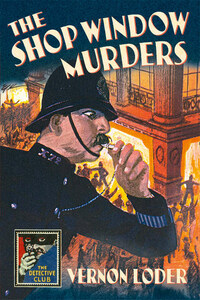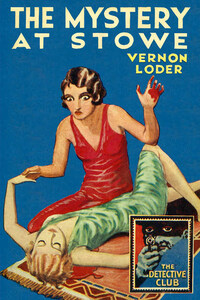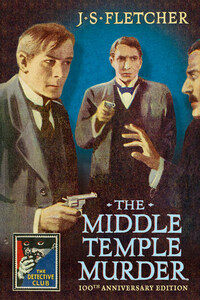‘THE DETECTIVE STORY CLUB is a clearing house for the best detective and mystery stories chosen for you by a select committee of experts. Only the most ingenious crime stories will be published under the THE DETECTIVE STORY CLUB imprint. A special distinguishing stamp appears on the wrapper and title page of every THE DETECTIVE STORY CLUB book—the Man with the Gun. Always look for the Man with the Gun when buying a Crime book.’
Wm. Collins Sons & Co. Ltd., 1929
Now the Man with the Gun is back in this series of COLLINS CRIME CLUB reprints, and with him the chance to experience the classic books that influenced the Golden Age of crime fiction.
COLLINS CRIME CLUB
An imprint of HarperCollinsPublishers Ltd
1 London Bridge Street
London SE1 9GF
www.harpercollins.co.uk
Published by The Detective Story Club Ltd 2018
First published in Great Britain by
W. Collins Sons & Co. Ltd 1930
Introduction © Nigel Moss 2018
Cover design © HarperCollinsPublishers Ltd 1930, 2018
Vernon Loder asserts the moral right to be identified as the author of this work.
A catalogue copy of this book is available from the British Library.
This novel is entirely a work of fiction. The names, characters and incidents portrayed in it are the work of the author’s imagination. Any resemblance to actual persons, living or dead, events or localities is entirely coincidental.
All rights reserved under International and Pan-American Copyright Conventions. By payment of the required fees, you have been granted the non-exclusive, non-transferable right to access and read the text of this e-book on screen. No part of this text may be reproduced, transmitted, down-loaded, decompiled, reverse engineered, or stored in or introduced into any information storage and retrieval system, in any form or by any means, whether electronic or mechanical, now known or hereinafter invented, without the express written permission of HarperCollins.
Source ISBN: 9780008282981
Ebook Edition © October 2018 ISBN: 9780008282998
Version: 2018-08-24
Contents
Cover
Title Page
Copyright
Introduction
Chapter I
Chapter II
Chapter III
Chapter IV
Chapter V
Chapter VI
Chapter VII
Chapter VIII
Chapter IX
Chapter X
Chapter XI
Chapter XII
Chapter XIII
Chapter XIV
Chapter XV
Chapter XVI
Chapter XVII
Chapter XVIII
Chapter XIX
Chapter XX
Chapter XXI
Chapter XXII
Chapter XXIII
Chapter XXIV
Chapter XXV
Chapter XXVI
Chapter XXVII
Keep Reading …
The Detective Story Club
About the Publisher
VERNON LODER was a popular and prolific author of Golden Age detective mysteries and spy thrillers. He wrote 22 titles during the decade from 1928 to 1938. Subsequently Loder has been out of print and largely overlooked. Fortunately, the tide is turning. In 2013/14, two noted crime fiction commentators, Curtis Evans and J. F. Norris, championed a number of early Loder titles, the latter in a series of enthusiastic reviews. A flurry of e-reader versions of Loder stories followed. But it was not until 2016 that Loder made his first return in print since the 1930s with the re-issue of his first novel The Mystery at Stowe (1928) as part of the Collins Detective Story Club reprint series. In the original Preface, the Club’s Editor, F. T. (Fred) Smith had welcomed Loder as ‘one of the most promising recruits to the ranks of detective story writers’.
The Shop Window Murders (1930) was Loder’s fourth novel, after The Mystery at Stowe (1928), Whose Hand? (1929) and The Vase Mystery (1929). It was published by Collins in the UK, and with the same title by Morrow in the USA. The storyline is intriguing and unusual, with one of Loder’s more ingenious plots. The setting is Mander’s Department Store in London’s West End (loosely modelled on Selfridges in Oxford Street), owned by Tobias Mander and famous for its elaborate window displays. Early on a Monday morning, the crowds of passers-by pause to watch the window blinds being raised on a new weekly display, but the onlookers quickly realise that one of the wax figures is in fact a human corpse, shot and placed among the mannequins in the window display. Shortly afterwards a second victim is discovered, and this striking tableau begins a baffling and complex mystery tale. Was it murder and suicide, or double murder?
Loder draws a wide cast of diverse suspects, each with a motive for the killings. To a toxic mix of jealousy, fear, panic and anger, he adds further colour to the story with a proliferation of bizarre circumstances and enigmatic clues, displaying some fiendishly intricate plotting.
The case raises a fundamental question: why did the perpetrator of the killings leave so many signs and clues? Did it show a confused mind? Or was this a deliberate and clever attempt to confuse the police by leaving a trail of red herrings and different angles which implicated more and more characters and made proof of guilt harder to determine?











